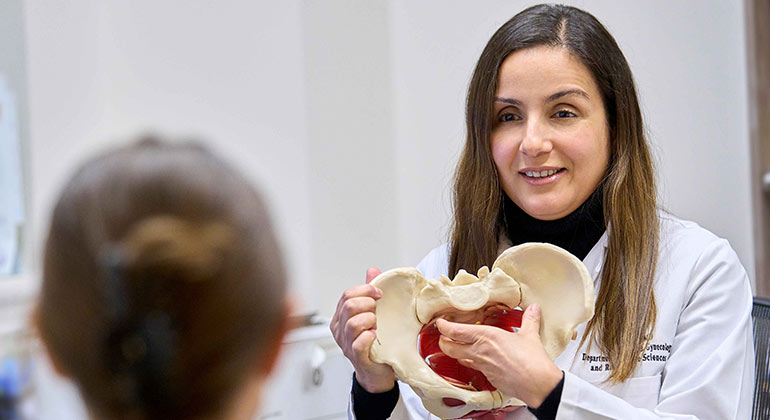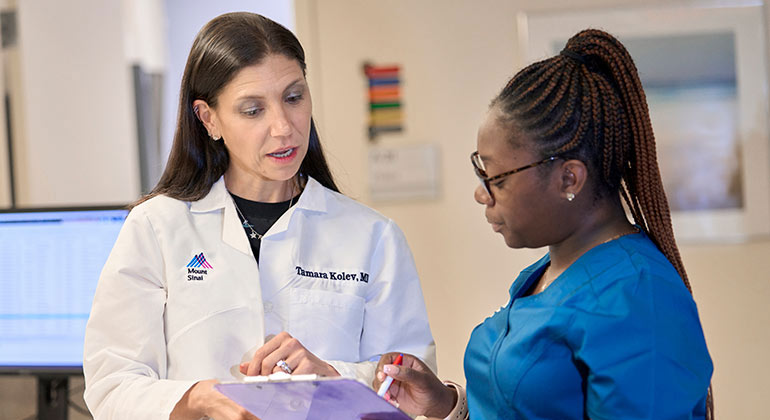Diagnosis and Treatment


At Mount Sinai’s Fibroid Center of New York, we start by diagnosing the number, size, location, and type of fibroids you have. We review your medical history and any radiologic tests you may have received already. Then we perform a full physical examination. We may also use additional tests to fully understand your condition. Tests might include:
- Sonogram: This imaging test lets us see if you have a fibroid.
- Magnetic resonance imaging: This imaging test shows us how many fibroids you have and where they are located.
- Biopsy: With this procedure, we remove a small amount of your uterine tissue for testing in a lab.
Once we have all the information we need, we will sit down with you to discuss your condition and treatment options. We work with you to develop a treatment plan that works for you.
Treatments We Offer
We tailor your treatment specifically to your medical condition. If you are not experiencing symptoms, for instance, we may not need to do anything invasive. We may be able to just check your fibroids periodically and will recommend supplements to help keep your fibroids from becoming a problem. If you are feeling symptoms, there are a number of approaches we can use. These include nonsurgical methods, minimally invasive approaches, and surgical procedures.
Nonsurgical methods include:
- Supplemental vitamin D and green tea: Both have been shown to suppress fibroid growth and reduce symptoms.
- Birth control pills: These pills may reduce bleeding and cramping.
- Hormonal therapy: This approach suppresses fibroid growth and abnormal bleeding.
- Progesterone-releasing intrauterine device: This device slowly releases the hormone progesterone to help decrease bleeding.
Minimally invasive approaches offer several advantages over open surgery. Performed in an outpatient setting, they do not require general anesthesia, cause minimal to no scarring, and have a short recovery time. Options include:
- Radiofrequency ablation (Sonata System): This treatment uses heat generated by electrical current to destroy fibroids. Most women can return to normal activity the day after the procedure. Mount Sinai was the first in Manhattan to offer this treatment.
- Uterine fibroid embolization: With this procedure, we insert a small tube (called a catheter) into the blood vessels that feed the fibroids. We inject small particles to block the blood flow. This causes the fibroid to die. A targeted procedure, uterine fibroid embolization does not affect the uterus.
Surgical approaches include:
Myomectomy: This is the surgical removal of the fibroids. We use a variety of approaches, depending on the size, number, and location of the fibroids. Approaches include:
- Laparoscopic/robotic myomectomy: We make three to five small incisions in the abdomen. Then we reduce the fibroids into small pieces and remove the pieces.
- Vaginal myomectomy (hysteroscopic myomectomy): We remove submucosal fibroids through the vagina, without incisions.
- Abdominal myomectomy: An incision along the bikini line allows the surgeon to reach the uterus and remove the fibroids while sparing the uterus.
Hysterectomy: This procedure removes the uterus. We may also remove your ovaries and cervix as well, if appropriate. We can do this using an abdominal incision, vaginal approach, or robotic/laparoscopically. We only perform a hysterectomy when absolutely necessary. Whenever possible, we prefer a less invasive treatment. Regardless of your age, having fibroids should not mean your only choice is hysterectomy. We understand what a difficult decision this can be and can help you make the best choice for you.